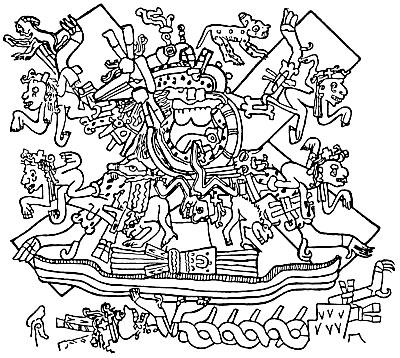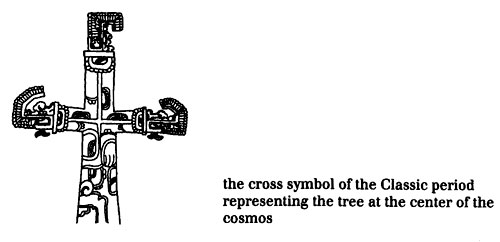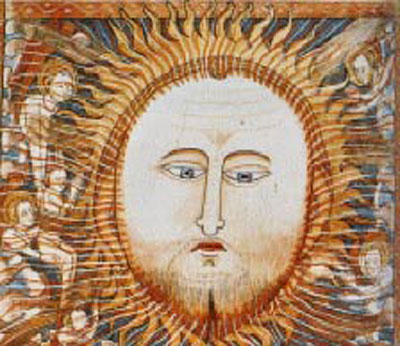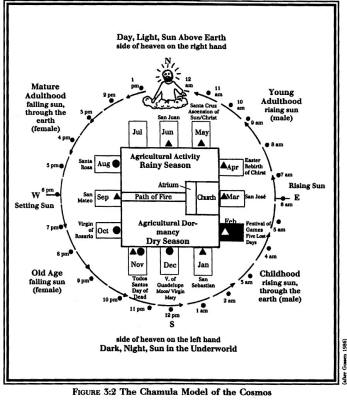|
In Jesus as the Sun throughout History, I provide evidence that the New Testament figure of "Jesus Christ" has been perceived as the "sun of righteousness" (Mal 4:2) since the formation of Christianity, appearing in numerous solar roles, possessing an abundance of solar attributes, and perceived by a variety of cultures as a sun god. Among these cultures who easily saw in Christ the face of their own solar deities are the peoples of Central America, including the Aztecs and Maya.
In Jesus as the Sun, I include a section entitled "Christ as the Sun in Native Traditions" in which I quote prominent scholars and anthropologists of the Americas concerning the native perception of the Christian messiah.
For example, the Canadian natives the Montagnais/Innu were related in 1627 as believing Jesus to be the sun. In this same regard, the Christianized Mexican natives the Nahua,
"The Mexicans 'combine the sun and Christ into a composite personality who is the masculine creative force in the Nahuat universe.'"
One of the authorities I cite in my article is Dr. James M. Taggart, a professor of mine at Franklin and Marshall College, who discusses Mesoamerican celebrations in his book Nahuat Myth and Social Structure (57-68):
"The major winter solstice ceremony celebrates the birth of Christ and the annual re-birth of the sun as it begins to move north bringing more heat and light with gradually longer and warmer days."
It is obvious that the native peoples, so in tune with their environment, recognized in Christ a solar deity whose attributes, we have seen elsewhere, represent mythical motifs of pre-Christian gods and goddesses from around the Mediterranean and beyond.
Because the Mesoamericans developed their culture, religion and mythology in isolation, they retained the nature-worshipping and astrotheological meaning and symbolism behind the anthropomorphized myths and readily saw that Christ was more of the same such elemental-spiritual configuration.
The Maya and Christianity
When the Mesoamerican peoples called the Maya were conquered by the Spanish beginning in the 16th century and subjugated under the Catholic Church, they did not simply remove their vast and ancient knowledge of the world and cosmos to replace it with the biblical and Christian worldview.
Instead, like the Indians, the Mesoamericans simply absorbed Christian doctrine and myths into their own perspective, as part of the cosmic play of the time.
Like the Spaniards, who were astonished at the parallels between the Catholic and Mesoamerican religion, the Maya recognized the similarities between their gods and the biblical God the Father, Jesus, Virgin Mary and various saints.
Thus, rather than forgetting their enormous body of knowledge dating back thousands of years in favor of a supposedly superior spiritual tradition which in reality pales by comparison, the Mesoamericans merely merged this relatively minor perception into their vaster cosmic comprehension.
"Like the Spaniards, who were astonished at the parallels between the Catholic and Mesoamerican religion, the Maya recognized the similarities between their gods and the biblical God the Father, Jesus, Virgin Mary and various saints."
In this syncretism of religious ideas and deities, which exemplifies behavior found globally for thousands of years, including in pre-Columbian America itself, the Maya added the new Spanish god called "Dios" to their pantheon, along with his son, the Sun-Christ.
The figure named Jesus merits two gods, younger and older brothers, in the Mesoamerican pantheon. In this way, although the god Halal Dios is equivalent to "God Almighty" - likewise equated by the Maya with the sun - he represents merely another aspect of divinity, brought by the Spaniards into the equation, as part of a much more universal concept significantly revolving around the World Tree or Milky Way, from which we emanate and to which we return.
In this regard, the Maya were accurate in their perception that we are all "star stuff" and that the Milky Way is the center of a galaxy in which our Earth is located.
Quetzalcoatl/Kukulkan, the Maize God and Christ
The Mesoamericans such as the Maya and Aztecs recognized in the figure of Jesus Christ brought to them by the Spaniards an echo of their various gods, including and especially Kukulkan or Quetzalcoatl, who was syncretized with the ancient Maize God, depicted as entering the underworld, dying and being resurrected, as is appropriate for a seed being planted and grain bursting forth.
The Maize God was central to the Maya religion, which acknowledged the plant's massive importance to the Maya civilization.
Hence, he was essentially the savior of the peoples, and important myths were constructed around him (or her, as maize was depicted also as a goddess, likewise appropriate).
The maize god is a dying and rising savior whose head, when he is killed, is hung on a tree.
This common archetype or pattern, with a different expression based on locale and era, can be found in numerous places globally, based on observation of natural phenomena.
"The maize god is a dying and rising savior whose head, when he is killed, is hung on a tree."
The maize god is also solar, as is the figure of Quetzalcoatl or Kukulkan, and this story of death and resurrection or rebirth can be associated also with the cycles of the sun. In this regard, the cross as a solar symbol can be found around the globe dating back many thousands of years, representing the four directions or cardinal points, ruled by the sun.
The Solar Cross
The cross was a central feature to Maya religion, as a solar symbol as well as the World Tree or Milky Way, the origin of all life.
Hence, the sacred cross was depicted widely and is, indeed, the Maya glyph for "sun." As the foliated tree, the cross could be found carved on stelae and tombs.
Thus, when the Spaniards arrived under the sign of the cross, the Maya believed they were part of the "cosmic play," so to speak.
"The cross as a solar symbol can be found around the globe dating back many thousands of years, representing the four directions or cardinal points, ruled by the sun."
In their subjugation, the Maya syncretized Christ to their solar and maize god, recognizing Jesus' dying and rising essentially as the same theme, albeit it the Christian myths had lost their more cosmic meaning, since they had fallaciously been historicized and depicted as revolving around a human of a particular ethnicity.
This latter type of anthropomorphization was quite common to Maya myth as well, obviously, since the sun and corn, along with many other natural and celestial elements and bodies, likewise were changed into "real people" about whom fabulous tales were told.
Thus, the Mesoamericans were not surprised by the stories, and they saw them as quite similar to their own - as do comparative mythologists to this day.
Yahweh as One of the Many
Providing an example of how the Maya did not simply forget all their cosmic knowledge - which included close scientific observations of numerous planets, stars and constellations - but merely added the Catholic divinities to their pantheon, Mayanist Dr. Eric Thompson describes a Maya ritual that continues to be practiced, and remarks:
"The God of the Christians is added to the old list of pagan deities."
The Sun-Christ
In this way, we discover the Maya carrying in procession an image of what is called the "Sun-Christ."
As Mayan Dr. Linda Schele recounts:
For three days, Duncan and I watched the Pasiones and the Flowers run the flowered banners that are the Sun-Christ around the square of Chamula. (Freidel, Schele and Parker, Maya Cosmos, 117)
Describing figures of monkeys who are "creatures from a previous Creation," Schele remarks:
It should be noted that in Christian myth, Jesus is depicted as spending three days in the underworld, called the "Harrowing of Hell," a mythical motif found in Egypt, the Levant and elsewhere.
In this dying-and-rising motif, the Maya recognized the same natural symbolism of the solar rays, rain and other elements reaching into the underworld/ground to sprout the seed and bring forth the life-giving foliage.
This same tale is used also to describe various celestial landmarks and events, as the Maya truly believed that "as above, so below."
"In the highest levels of heaven dwells Almighty God the Sun who traverses his flowery path across the sky once a day."
As another example of post-Conquest Maya syncretism of Christian ideas, Schele relates:
In the highest levels of heaven dwells Almighty God the Sun who traverses his flowery path across the sky once a day. The rising of the sun is the daily affirmation of the dynamic and participatory presence of beneficial spiritual forces in the lives of the people.
This general concept is universal among the Maya. The sun is so central in the mythology of the Tzotzil Maya that they believe north and south, the "sides of heaven," were first defined when the sun made its original journey across the cosmos.
To these contemporary Maya all the directions have sacred properties.
West is the entryway into the earth where the Sun-Christ had to go before he could rise in triumph. South is nadir, the darkness where the Sun-Christ first traveled before arising from death in the east.
Ascending to the zenith in the north, Christ slew his mythological enemies with his curative heat. (Freidel, 128)
"West is the entryway into the earth where the Sun-Christ had to go before he could rise in triumph."
|




